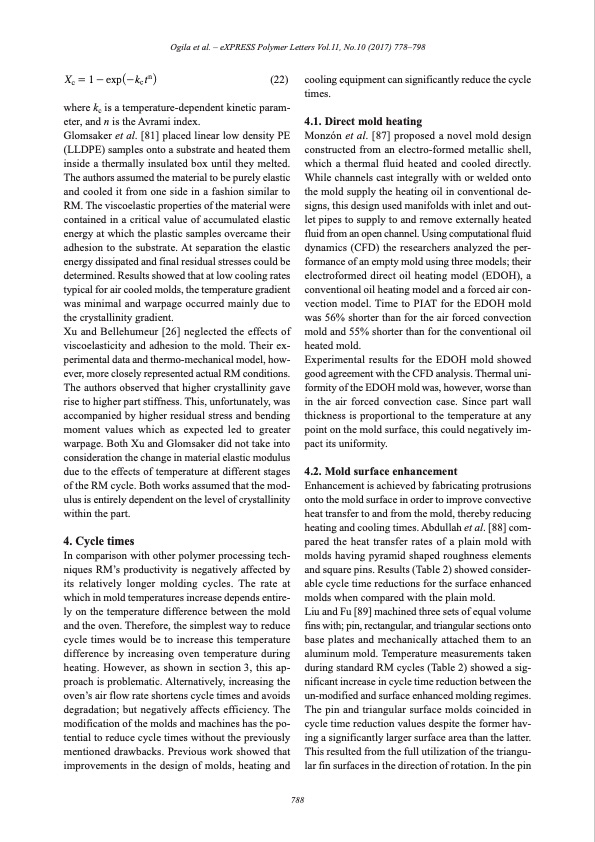
PDF Publication Title:
Text from PDF Page: 012
Ogila et al. – eXPRESS Polymer Letters Vol.11, No.10 (2017) 778–798 Xc =1-expR-kctnW (22) cooling equipment can significantly reduce the cycle times. where kc is a temperature-dependent kinetic param- eter, and n is the Avrami index. Glomsaker et al. [81] placed linear low density PE (LLDPE) samples onto a substrate and heated them inside a thermally insulated box until they melted. The authors assumed the material to be purely elastic and cooled it from one side in a fashion similar to RM. The viscoelastic properties of the material were contained in a critical value of accumulated elastic energy at which the plastic samples overcame their adhesion to the substrate. At separation the elastic energy dissipated and final residual stresses could be determined. Results showed that at low cooling rates typical for air cooled molds, the temperature gradient was minimal and warpage occurred mainly due to the crystallinity gradient. Xu and Bellehumeur [26] neglected the effects of viscoelasticity and adhesion to the mold. Their ex- perimental data and thermo-mechanical model, how- ever, more closely represented actual RM conditions. The authors observed that higher crystallinity gave rise to higher part stiffness. This, unfortunately, was accompanied by higher residual stress and bending moment values which as expected led to greater warpage. Both Xu and Glomsaker did not take into consideration the change in material elastic modulus due to the effects of temperature at different stages of the RM cycle. Both works assumed that the mod- ulus is entirely dependent on the level of crystallinity within the part. 4. Cycle times In comparison with other polymer processing tech- niques RM’s productivity is negatively affected by its relatively longer molding cycles. The rate at which in mold temperatures increase depends entire- ly on the temperature difference between the mold and the oven. Therefore, the simplest way to reduce cycle times would be to increase this temperature difference by increasing oven temperature during heating. However, as shown in section 3, this ap- proach is problematic. Alternatively, increasing the oven’s air flow rate shortens cycle times and avoids degradation; but negatively affects efficiency. The modification of the molds and machines has the po- tential to reduce cycle times without the previously mentioned drawbacks. Previous work showed that improvements in the design of molds, heating and 4.1. Direct mold heating Monzón et al. [87] proposed a novel mold design constructed from an electro-formed metallic shell, which a thermal fluid heated and cooled directly. While channels cast integrally with or welded onto the mold supply the heating oil in conventional de- signs, this design used manifolds with inlet and out- let pipes to supply to and remove externally heated fluid from an open channel. Using computational fluid dynamics (CFD) the researchers analyzed the per- formance of an empty mold using three models; their electroformed direct oil heating model (EDOH), a conventional oil heating model and a forced air con- vection model. Time to PIAT for the EDOH mold was 56% shorter than for the air forced convection mold and 55% shorter than for the conventional oil heated mold. Experimental results for the EDOH mold showed good agreement with the CFD analysis. Thermal uni- formity of the EDOH mold was, however, worse than in the air forced convection case. Since part wall thickness is proportional to the temperature at any point on the mold surface, this could negatively im- pact its uniformity. 4.2. Mold surface enhancement Enhancement is achieved by fabricating protrusions onto the mold surface in order to improve convective heat transfer to and from the mold, thereby reducing heating and cooling times. Abdullah et al. [88] com- pared the heat transfer rates of a plain mold with molds having pyramid shaped roughness elements and square pins. Results (Table 2) showed consider- able cycle time reductions for the surface enhanced molds when compared with the plain mold. Liu and Fu [89] machined three sets of equal volume fins with; pin, rectangular, and triangular sections onto base plates and mechanically attached them to an aluminum mold. Temperature measurements taken during standard RM cycles (Table 2) showed a sig- nificant increase in cycle time reduction between the un-modified and surface enhanced molding regimes. The pin and triangular surface molds coincided in cycle time reduction values despite the former hav- ing a significantly larger surface area than the latter. This resulted from the full utilization of the triangu- lar fin surfaces in the direction of rotation. In the pin 788PDF Image | Rotational molding: A review

PDF Search Title:
Rotational molding: A reviewOriginal File Name Searched:
Rotational_molding_A_review_of_the_models_and_mate.pdfDIY PDF Search: Google It | Yahoo | Bing
Development of a solar powered Electric Ship The Electricship website originally started off as a project to develop a comprehensive renewable, affordable, modular electric ship... More Info
Modular Boat Hull Composite The case for a unsinkable, modular composite hybrid boat hull... More Info
MS Burgenstock Hybrid Electric Catamaran Lake Lucerne Unique shuttle servicing Lucerne to the Burgenstock Resort... More Info
Ground Power Unit GPU Powered by Lithium Ion Batteries The goal of the Ground Power Unit is to provide a readily accessible, modular, ready-to-power solution for remote power... More Info
| CONTACT TEL: 608-238-6001 Email: greg@electricship.com | RSS | AMP |